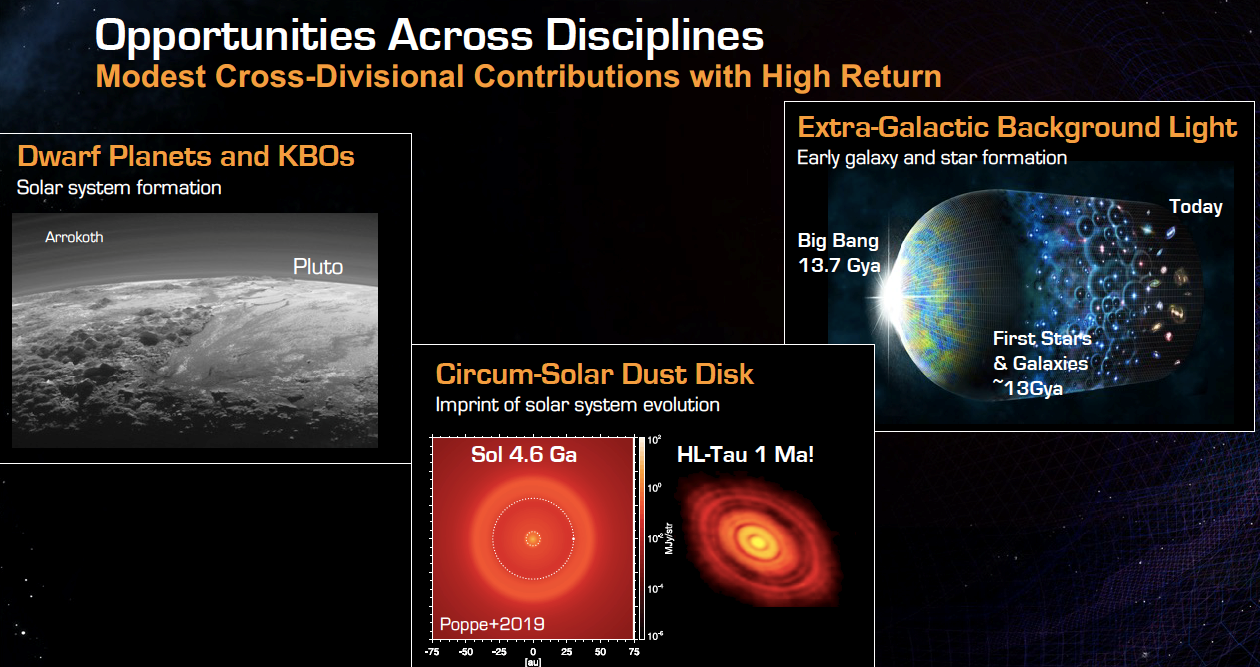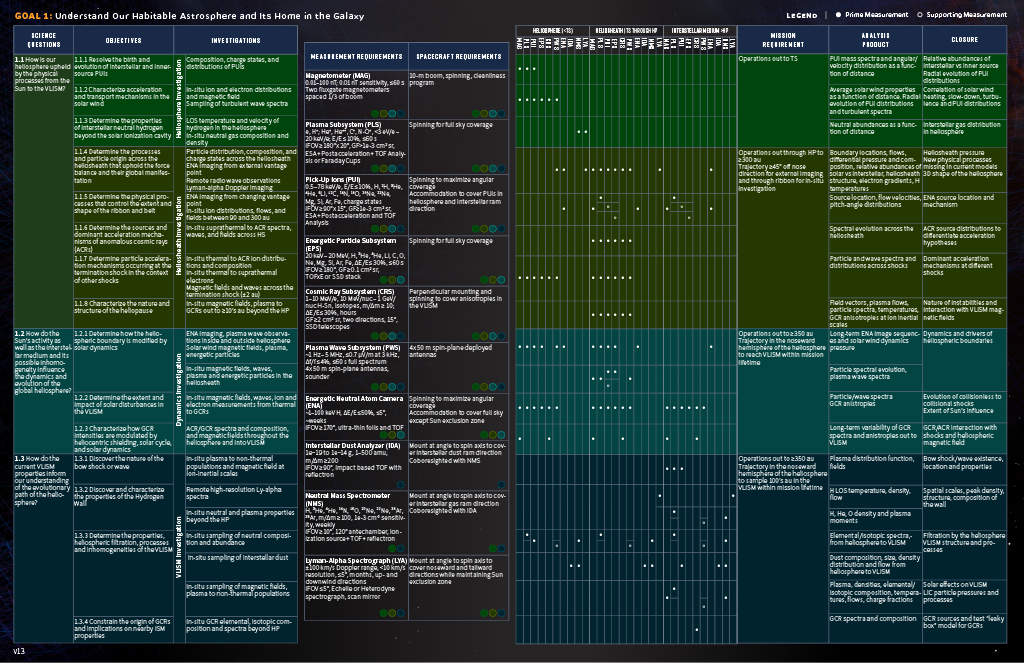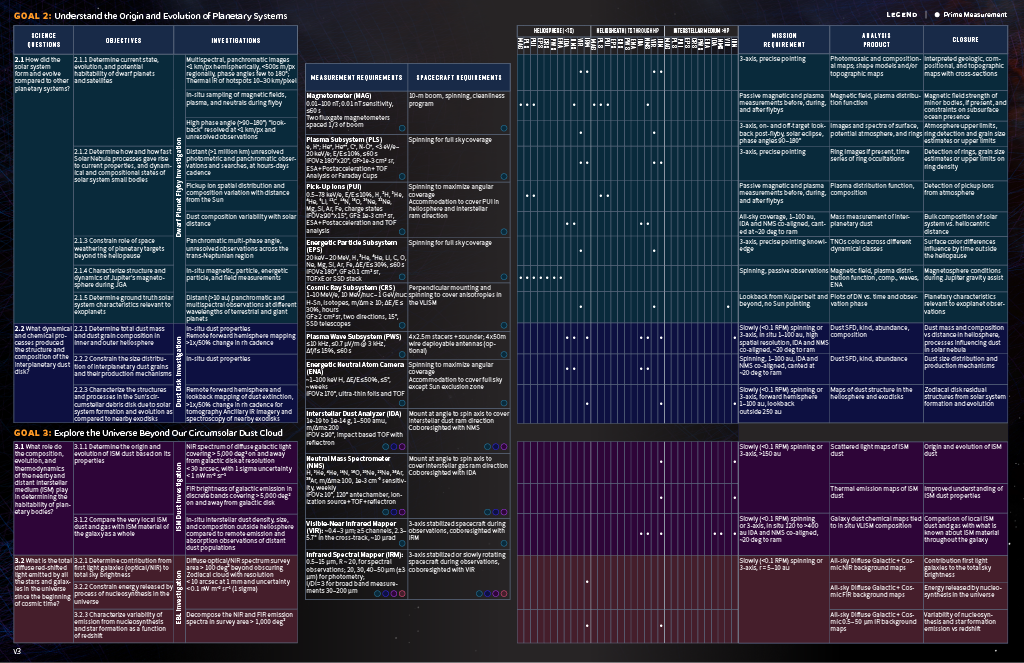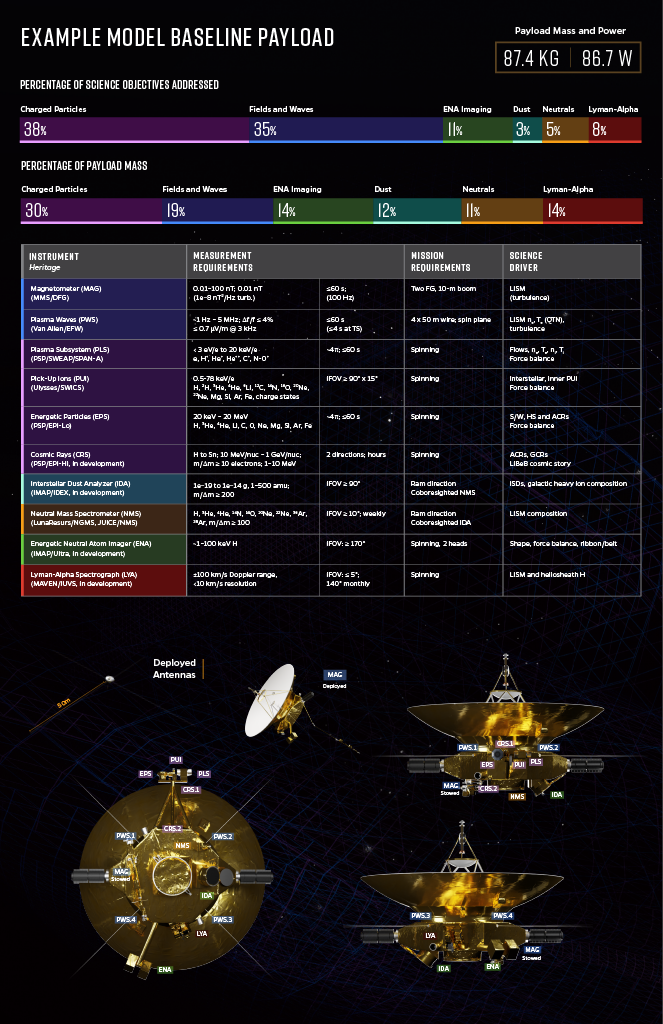Science
Overview
Our Star is one of hundred billion stars in the galaxy that plows through interstellar gas, plasma, and dust made up of the material from supernova remnants. With its pulsating solar wind, the Sun carves out the enormous habitable magnetic bubble encasing the entire solar system that we live in. Understanding the unique interaction mechanisms defining the boundary to interstellar space represents one of the oldest problems in space physics today. These mechanisms are also fundamentally responsible for the vast range of astrospheres observed around hundreds of other stars and exoplanetary systems in our galaxy. Beyond the heliosphere, the local interstellar medium presents an unexplored territory that has a decisive role in the shape and behavior of the entire heliosphere.
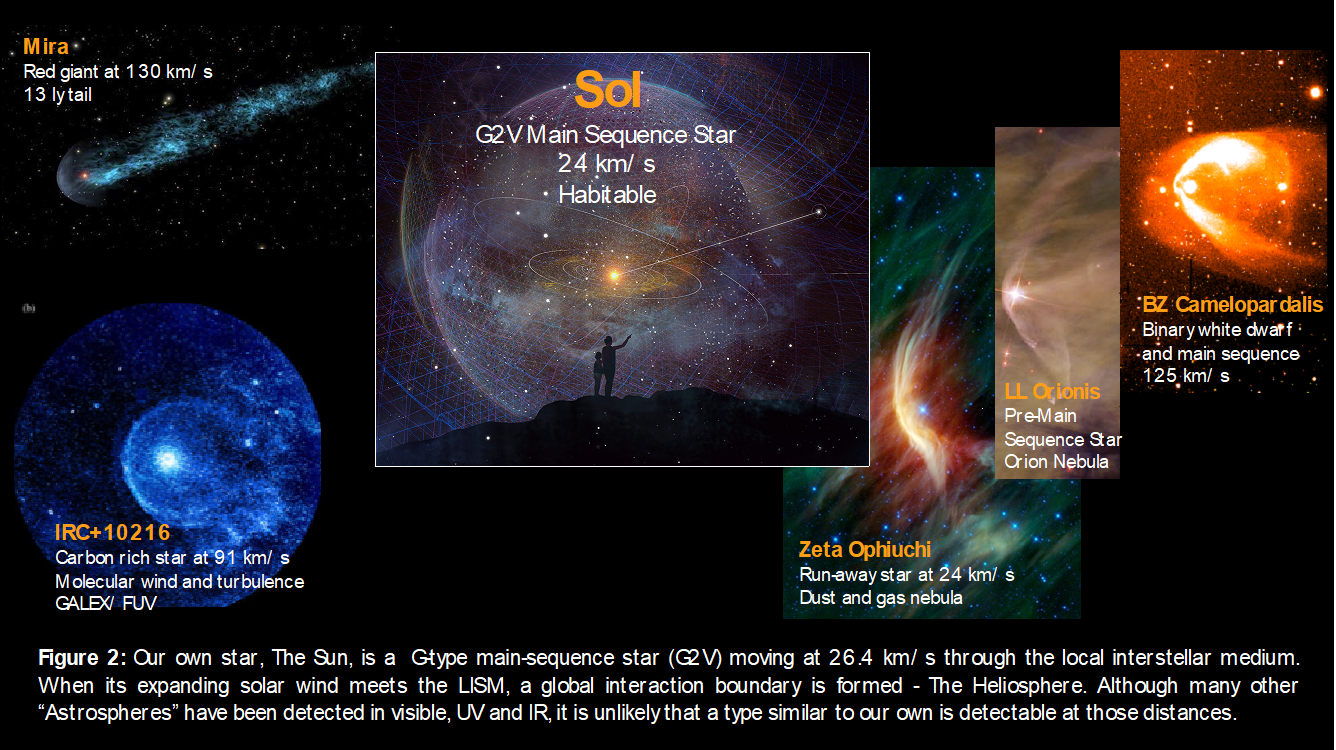
The potential for a mission to the Local Interstellar Medium (LISM) has been explored since the beginning of the space age. The remarkable science opportunities that arise from such an "Interstellar Probe" have fueled the community for almost six decades, resulting in multiple studies identifying compelling science goals and questions (Holzer, Mewaldt, and Neugebauer 1990; Liewer et al. 2001; McNutt 2002; Mewaldt and Liewer 2002; Wimmer-Schweingruber et al. 2009; Fiehler and McNutt 2012; Stone 2015; Wang 2018). Throughout those decades the general science questions have not really changed and revolve around the exploration of the heliospheric boundary and the properties of the unexplored LISM. A trajectory through the outer solar system and the Kuiper Belt, beyond our zodiacal cloud, naturally offers groundbreaking opportunities for Planetary Science and Astrophysics as well, even with relatively modest contributions.
The current study has developed its science goals from past efforts and current collaboration with the community. An interstellar probe would answer a wide range of questions from many different disciplines. The brief list below links to more detailed descriptions for each of the proposed topics, including specific questions and objectives for each field of inquiry. We have also provided links to the webinars previously presented by the Interstellar Probe Study team to provide further context and background to each topic.
A potential Interstellar Probe mission would seek to understand:
- Our Heliosphere as a Habitable Astrosphere and its Place in the Galaxy
- The Origin and Evolution of Planetary Systems
- How Early Galaxies and Stars were formed
Understanding our Heliosphere as a Habitable Astrosphere and its Place in the Galaxy
As the expanding, magnetized solar wind meets the plasma, gas and dust flows of the LISM, a complex and vast interface is created that separates the solar environment from the unperturbed interstellar environment that our solar bubble plows through. The interface region spans a sun-centered distance of 90 AU to at least 120 AU (for reference, Pluto is located at 39.5 AU from the Sun). This region is the culmination of remarkable physical processes of astrophysical scales that dictate the entire shape, extent and dynamics of our heliosphere and astrospheres of other star systems.
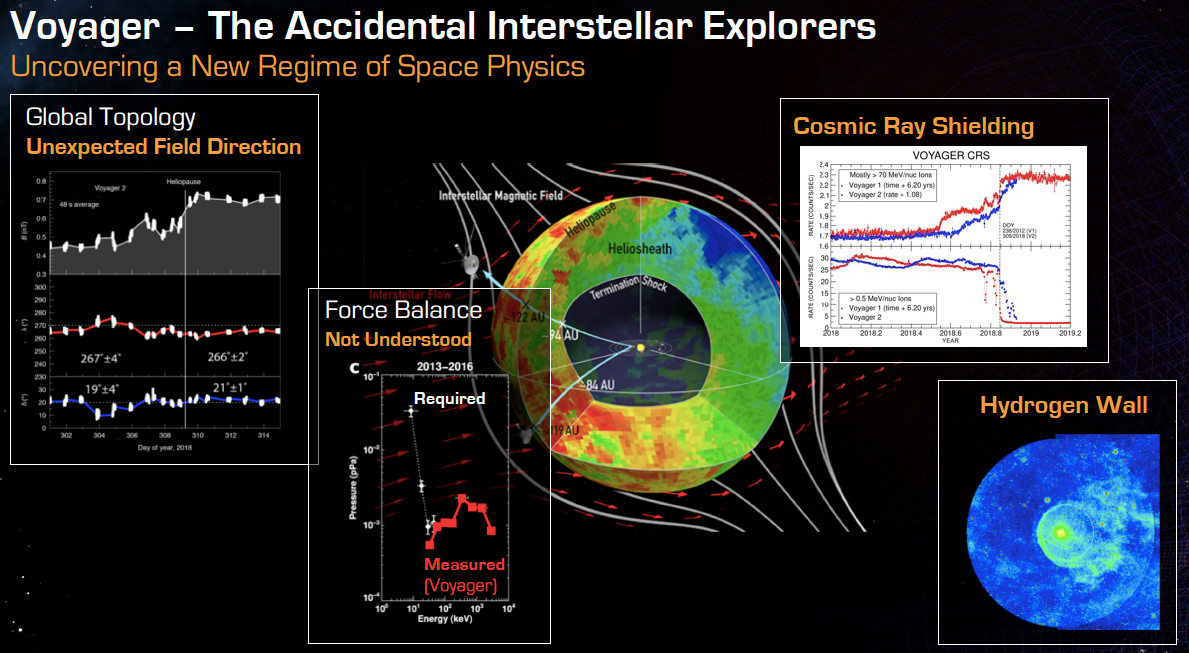
The limited knowledge we have of this region has been collected by Voyager 1 and 2 that uncovered completely unexpected phenomena that could not be understood with the science payload designed for planetary flybys during the Grand Tour. Several remote observations from deep inside the heliosphere have been seeking information for decades of the heliospheric boundary and what lies beyond, and have found tantalizing evidence for large-scale structures and interactions that cannot be fully explained.
Energetic Neutral Atoms (ENAs) and Ultraviolet (UV) are powerful techniques to gain information on the global structure and dynamics of the boundary, but have all been conducted from vantage points from deep inside the heliosphere looking out making it difficult to interpret the observations uniquely. The emission patterns from the remote Energetic Neutral Atom (ENA) observations by NASA IBEX and Cassini missions have revealed completely unexpected emission patterns from the boundary region that are not yet understood, but seem to indicate large-scale features and variations relating to the shape and thickness of the heliosheath and the external interstellar magnetic field direction. The upcoming NASA IMAP mission will characterize these features at unprecedented resolution from 1 AU and will serve as a crucial guide for an Interstellar Probe mission through the boundary. UV observations conducted by the SOHO, Voyager and New Horizons missions have resolved interstellar hydrogen interacting with the heliosphere forming a "Hydrogen Wall" and an unexplained significant excess of hydrogen.
Interstellar space, or LISM beyond the boundary of our heliosphere is largely unexplored territory and may very well be where an Interstellar Probe would make its most historic scientific discoveries. The unfiltered LISM holds the key to understanding the interaction with the global heliosphere (and other astrospheres), the nearby galactic environment, and how matter in the galaxy originated and evolved. It has long been thought that the heliosphere is completely surrounded by the Local Interstellar Cloud. New evidence is mounting that the heliosphere is in contact with no less than four different interstellar clouds and that the Sun is entering a new region of interstellar space with drastically different properties within relatively short galactic time scales (~6000 years) (Linsky et al., 2019). In a sense, a galactic event with the heliosphere in the leading role is happening around us, which makes the exploration of the LISM timely. Even modest changes in the charge fraction would have drastic consequences for the size of the heliosphere (Baranov & Malama, 1993).
All knowledge we have of the surrounding LISM are average properties (neutral and singly ionized elements in the UV range) derived from absorptions spectra along line of sights towards the nearest handful of stars, and from measurements of interstellar PUIs and dust penetrating the heliosphere (43 total detections to date). Sampling the local ionization state, flows, and chemical and isotopic composition of particles and dust of the unprocessed surrounding LISM would therefore be of vital to our understanding of the heliospheric interaction; provide the first direct determination of the interstellar cloud properties, and provide historical constraints on the chemical evolution of the galaxy and nucleosynthesis. Furthermore, venturing in to an unexplored territory is guaranteed to offer new discoveries of questions that we never knew how to ask.
With the new availability of larger launch vehicles than ever before, humanity now has been given access to the heliospheric boundary and to the galactic environment beyond. In order to design possible mission architectures for this historic exploration, a set of science questions and objectives must be formulated that can be used to derive rigorous requirements on measurements, spacecraft and operations. Below is an example of such compelling questions that have been assembled from past studies and by the community in this study.
